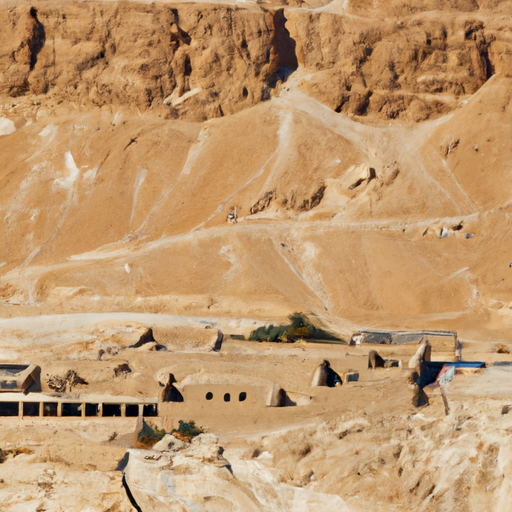This blog post takes readers on an enthralling journey through Israel's architectural marvels, exploring their historical significance, unique designs, and the stories they tell about the country's rich cultural heritage. From ancient ruins to modern skyscrapers, each structure is a testament to the resilience and creativity of the Israeli people.
"The Ancient Structures: A Glimpse into the Past?"
As you wander through the streets of Israel, it is impossible to ignore the ancient structures that dot the landscape. From the iconic Western Wall in Jerusalem to the stunning ruins of Caesarea, these architectural marvels offer a captivating glimpse into the past. These ancient structures not only showcase the remarkable engineering skills of their creators but also provide a window into the rich history and cultural heritage of the region.
One such example is the city of Petra, located in southern Jordan but with significant historical ties to Israel. This UNESCO World Heritage Site is renowned for its intricate rock-cut architecture, with buildings carved directly into the rose-colored sandstone cliffs. Walking through the narrow Siq, a winding canyon that leads to the Treasury, feels like stepping back in time to an era long gone. The craftsmanship and attention to detail displayed in these ancient structures are truly awe-inspiring, leaving visitors in awe of the skills possessed by the architects of the past.
You can go and visit these sites independantly or via daily tour in Jerusalem.
Another remarkable example is Masada, an ancient fortification perched on top of a rock plateau overlooking the Dead Sea. This UNESCO World Heritage Site holds great significance in Jewish history and has become a symbol of resilience and determination. The architectural marvels found at Masada, including the impressive palaces, bathhouses, and defensive walls, offer a fascinating insight into the lives of the people who once inhabited this remote desert fortress.

An image showcasing the formidable ancient ruins of Masada, located on a rugged desert plateau.
Modern Architecture in Israel: A Fusion of Cultures?
Israel's modern architecture is a testament to the country's cultural diversity and its ability to blend various architectural styles. The architecture in Israel reflects the influences of different cultures, as the country has been a melting pot of immigrants from all over the world. This fusion of cultures has resulted in a unique architectural landscape that combines elements from the East and the West, creating a vibrant and eclectic mix.
One example of this fusion can be seen in the city of Tel Aviv, known for its Bauhaus architecture. Tel Aviv was declared a UNESCO World Heritage Site for its collection of over 4,000 Bauhaus-style buildings, which were constructed during the 1930s by German Jewish architects who emigrated to Israel. The clean lines, functional design, and emphasis on natural light of the Bauhaus movement blend seamlessly with the Mediterranean climate and lifestyle, creating a harmonious architectural style that is distinctly Israeli.
In addition to the Bauhaus influence, modern architecture in Israel also draws inspiration from Islamic and Middle Eastern architectural traditions. The use of arches, domes, and intricate geometric patterns can be seen in many contemporary buildings, adding a touch of cultural richness to the urban landscape. Israeli architects have successfully combined these traditional elements with modern materials and construction techniques, resulting in stunning structures that pay homage to the country's diverse heritage.
Furthermore, the influence of modernist architecture from the United States and Europe is also evident in Israel's architectural scene. The sleek lines, glass facades, and open spaces characteristic of modernist design have found their way into the country's skyscrapers, commercial buildings, and residential complexes. This international influence, coupled with the local cultural context, has led to the creation of a truly unique architectural style that reflects Israel's global connections and its commitment to innovation.
"From Bazaars to Skyscrapers: What does Israel's evolution tell us?"
Israel's architectural evolution tells a compelling story of the country's growth and development over the years. From traditional bazaars to modern skyscrapers, the changing architectural landscape reflects Israel's transition from a predominantly agrarian society to a thriving urban center. The architectural transformation is a reflection of the country's economic, social, and technological progress.
One significant aspect of Israel's architectural evolution is the shift from traditional bazaars to modern urban centers. Historically, bazaars served as vibrant marketplaces where people gathered to buy and sell goods. These bustling hubs were characterized by narrow alleyways, intricate architectural details, and a vibrant atmosphere. However, as Israel embraced modernization, these traditional bazaars gradually gave way to modern shopping malls and commercial complexes. This transition signifies the country's transition from a traditional economy to a more consumer-driven society.
Another notable aspect of Israel's architectural evolution is the proliferation of skyscrapers in its major cities. As the economy grew and urbanization accelerated, the demand for office space and residential buildings increased. This led to the construction of impressive skyscrapers that define the modern skyline of cities like Tel Aviv. These towering structures not only represent Israel's economic prosperity but also showcase the country's architectural prowess and ability to compete on a global scale.
Furthermore, Israel's architectural evolution also highlights the country's technological advancements. The incorporation of cutting-edge design, sustainable materials, and innovative construction techniques in modern buildings demonstrates Israel's commitment to environmental consciousness and technological progress. The development of smart buildings and the integration of renewable energy sources are further indicators of Israel's dedication to creating sustainable and energy-efficient urban environments.

A panoramic shot of Jerusalem's skyline, illustrating the evolution from traditional bazaars to towering skyscrapers.
"The Influence of Geographical Diversity on Israeli Architecture: Is it significant?"
Israel's architectural landscape is greatly influenced by its diverse geography, and this influence plays a significant role in shaping the country's architecture. The geographical diversity of Israel, from the lush green landscapes of the Galilee to the desert regions of the Negev, provides architects with a wide range of challenges and opportunities to create unique and innovative designs.
The coastal cities, such as Tel Aviv and Haifa, are heavily influenced by their proximity to the Mediterranean Sea. The sea breeze, sandy beaches, and vibrant beach culture have inspired the construction of modernist buildings with open spaces, large windows, and balconies that invite the outdoors in. These architectural designs emphasize a connection to nature and maximize the enjoyment of the coastal surroundings.
On the other hand, the desert regions of Israel have their own architectural requirements. With extreme temperatures and limited water resources, architects in these areas focus on sustainability and resource efficiency. Building designs incorporate passive cooling techniques, such as thick walls and shaded courtyards, to mitigate the harsh desert climate. The use of local materials, such as stone and earth, helps buildings blend seamlessly with the natural desert landscape.
The mountainous regions, such as Jerusalem and the Galilee, showcase a blend of ancient and modern architectural styles. The historical significance of these areas is reflected in the preservation and restoration of historic buildings, while new constructions incorporate elements that pay homage to the region's cultural heritage. The use of traditional stone masonry, arches, and domes adds a distinctive character to the architectural landscape.
Israel's architectural marvels are a testament to its diverse cultural heritage, ingenuity and resilience. The country's architecture is a canvas that narrates its historical journey, its struggles and triumphs. Exploring these structures provides a deeper understanding of the country's past and a unique perspective on its future. Indeed, Israel's architectural marvels are not just buildings, they are silent storytellers, each with a unique tale, waiting to be discovered.
כותב על עולם הרכב ובכלל – הנושאים שאני כותב עליהם הם כלליים מאוד, לכן אין להתייחס אליהם כאל המלצה או ייעוץ ואין לנקוט בפעולה כלשהי מבלי להתייעץ בצורה פרטנית עם מומחה






